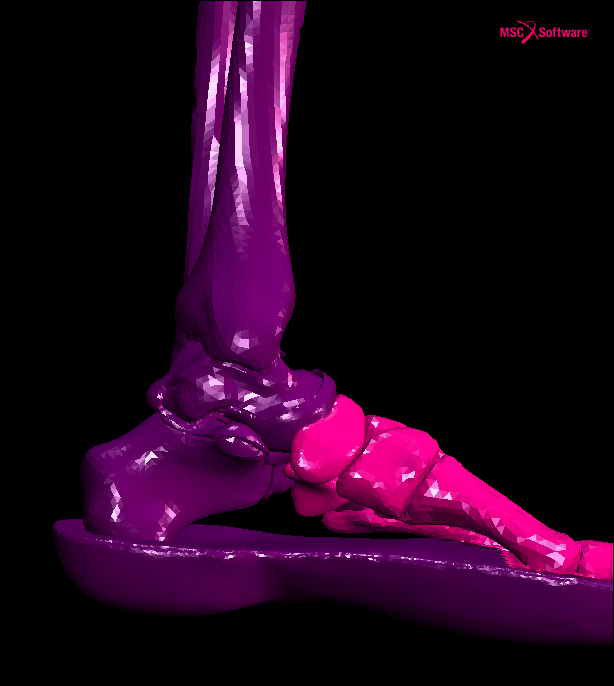Finite Element Analysis (FEA)
The finite element analysis (FEA) is a powerful, cost-effective tool to numerically solve complex engineering problems. This is achieved by subdividing the complex system of interest into smaller, simpler components called finite elements.
We are experts in performing advanced, non-linear FEA to provide solutions to stress, thermal, thermo-structural, modal, harmonic, dynamic and failure analysis problems. Our rigorous approach and experience ensures a high level of confidence to the final modelling outcome backed up by analytical calculations and sensitivity analyses.
We have offered our services to clients from a wide variety of industries and suggested feasible, cost-effective and impactful design modifications when required to improve the performance of a system and achieve key requirements.
Stress Analysis

FEA simplifies the process of performing stress analyses to investigate the structural integrity of a system when exposed to operating, environmental and other types of loading.
In such an analysis, the model's response, such as stresses, strains, displacements and reaction forces, is compared to allowable levels derived from material databases and relevant standards or guidelines.
Thermal Analysis
Thermal analyses are performed when heat exchange occurs within the system of interest due to conduction, convection or radiation, and the resulting temperature variation determines the integrity and performance of a product or process.
FEA facilitates the performance of such an analysis which is extremely complex due to the non-linear dependence of properties of most materials to temperature and the complex heat transfer relationships.

Thermo-structural Analysis

Heat exchange often occurs in structurally loaded systems. FEA allows the performance of complex thermo-structural analyses to investigate both the resulting stresses (as well as strains, displacements and reaction forces), which can be worsened by the thermal loading , and temperatures.
An example of a such an application would be a vessel exposed to both operating temperatures and pressures. This approach is also useful in engineering problems where thermal fatigue and creep are of concern.
Modal Analysis
A modal analysis is performed to determine the natural frequencies and mode shapes of a complex system or component.
The use of FEA simplifies this process and facilitates the implementation of design modifications to assess their effect on the system's vibration characteristics aiming to ensure adequate separation from the frequency of applied loads and minimise the resulting vibration levels.

Harmonic Analysis

A harmonic analysis explores the steady state response of a system to dynamically repeated loading.
Using FEA, the response of the system in the frequency domain when exposed to dynamic loads can be thoroughly investigated and improved.
Dynamic Analysis
A dynamic or transient analysis is required to determine the response of a system over time when exposed to dynamic loading conditions.
Using FEA, high-rate impact loading scenarios can be assessed, involving materials with time and rate dependent properties (non-linearly viscoelastic) such as foams, polymers and lattice structures.


Failure Analysis

FEA can be used for failure prediction including damage accumulation and crack propagation.
This is extremely useful in applications where a system is designed to reach plasticity in specific conditions and its response needs to be investigated even after failure.

Computational Fluid Dynamics (CFD)
CFD is a powerful, cost-effective tool to discretise, simplify and solve complex engineering problems related to fluid flow. Similarly to the FEA, CFD subdivides the geometry where flow is allowed to smaller compartments called elements.
In advanced applications, CFD can be coupled with FEA to investigate both the flow characteristics and the resulting structural loading of an application.

We are experts in using CFD to assist in problems our clients are facing in a variety of industries, such as oil and gas, electronics and automotive.
Using CFD, we can determine the flow characteristics, such as fluid pressure, velocity and temperature, and decide on design modifications to optimise the system's performance, achieve requirements, minimise energy losses and maximise the efficiency of heat exchange systems.

Multi-Body Dynamics (MBD)
MBD is a powerful motion analysis tool that investigates the kinematic behaviour of a mechanism consisting of solid members and rigid links. It is commonly used to determine the kinematic response of damping systems, such as the suspension of a vehicle, human body parts and power transmission mechanisms.
Often MBD is used to provide an appropriate input for for a detailed FEA or CFD analysis.

We are experts in using MBD to assist in the research and development process of products mainly from the automotive and medical technologies industries.